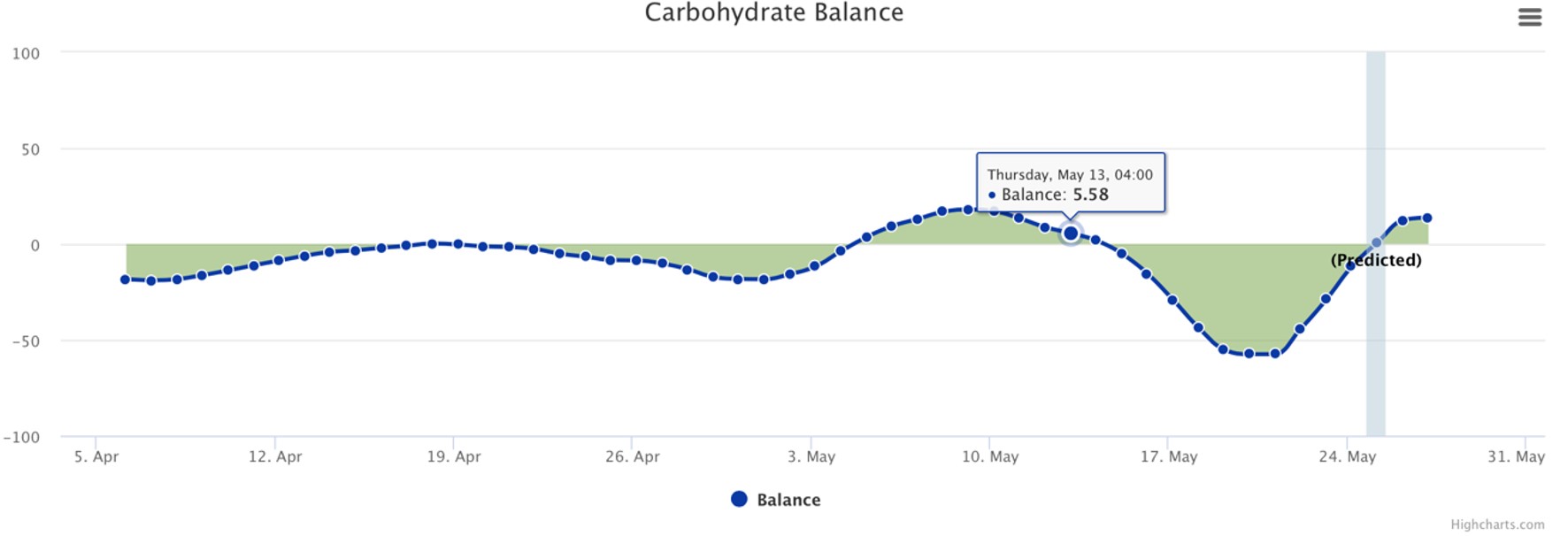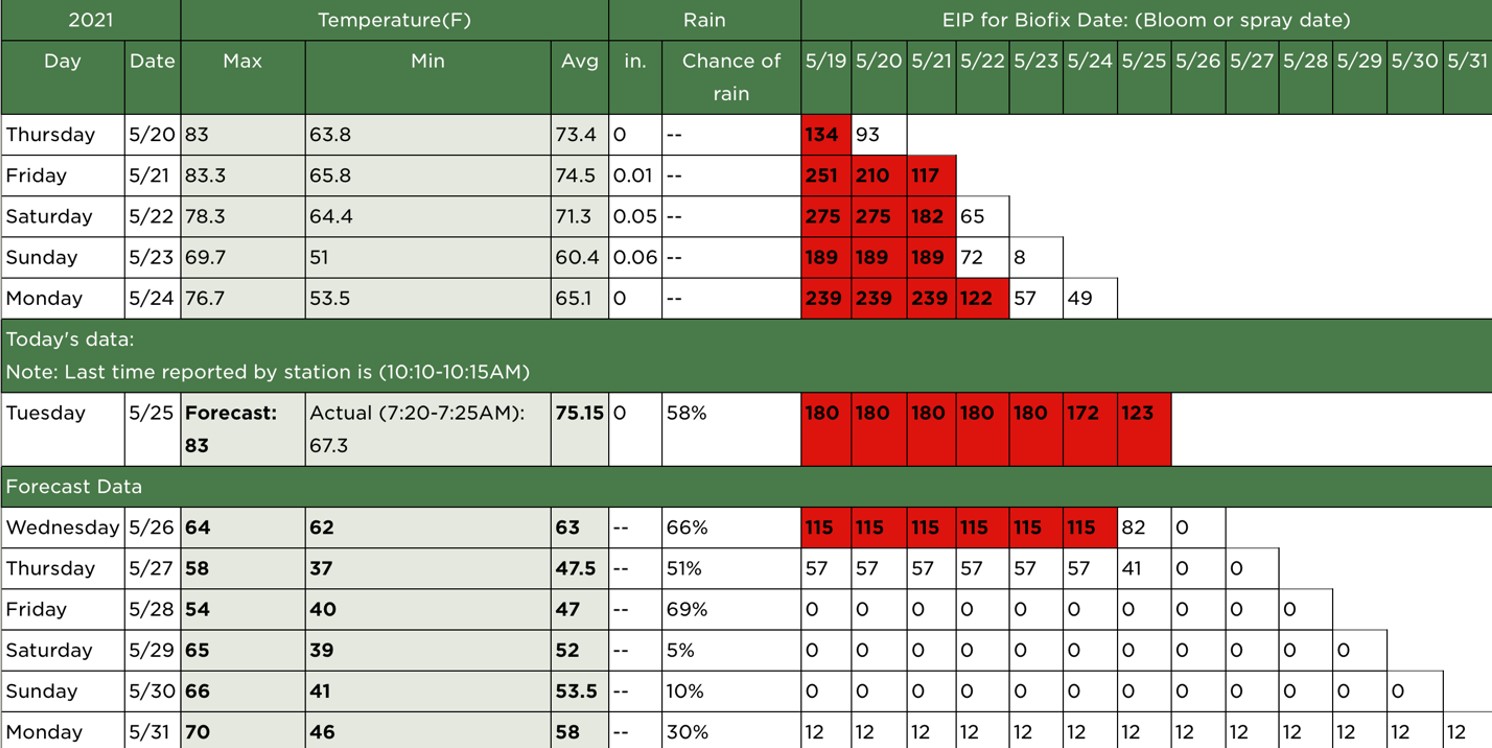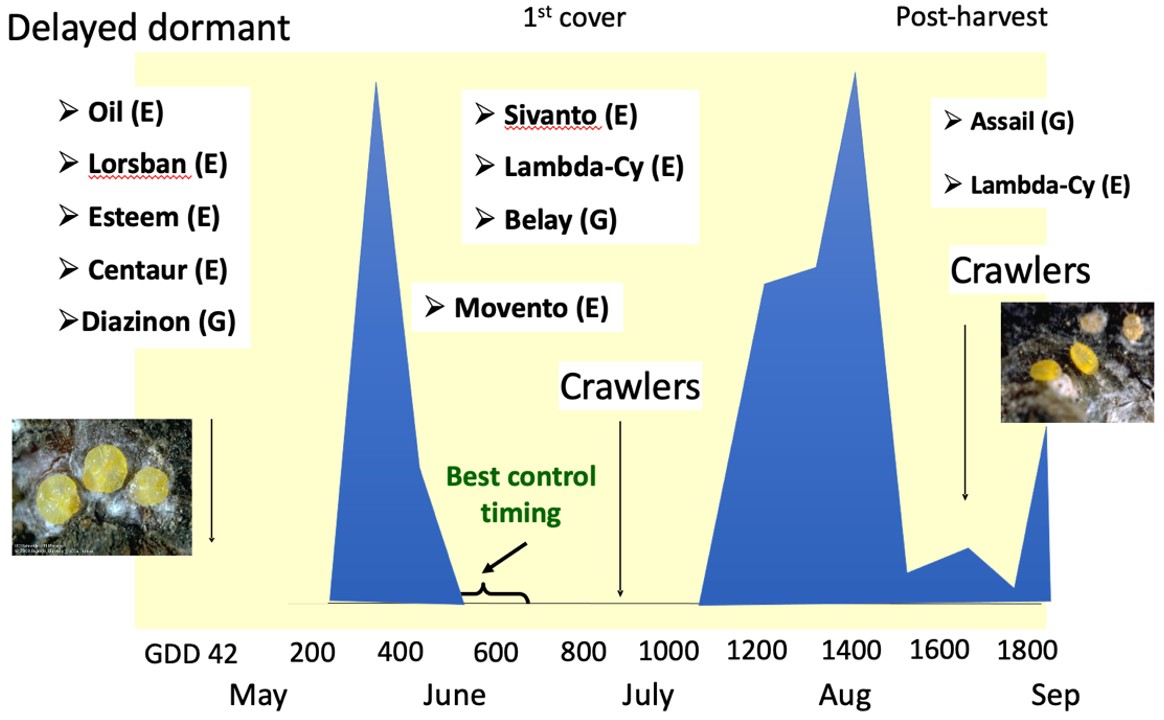Northwest Michigan fruit update – May 25, 2021
The recent warm weather has moved fruit crops along; sweet cherries are sizing, tart cherries are coming out of the shuck and apples range from petal fall to 3-4 millimeters.
Weather report
The 2021 season has certainly given us a variety of weather conditions. We had cool weather in mid-May, and some of the temperatures were 20-plus degrees Fahrenheit below our normal temperatures. Last week, temperatures increased, and we had daytime highs into the mid-80s. At the Northwest Michigan Horticulture Research Center, the Enviroweather station reported five days in a row of high 70s and low 80s. In addition to the daytime highs, nighttime temperatures only fell into the mid-70s for May 20, 21 and 22. Those day and nighttime temperatures moved the fruit crops along very quickly, and growers were busy over the latter part of the week and into the weekend covering new tissue for good disease control.
Because of the recent warm weather, our growing degree day (GDD) accumulations for this season are separating from our 31-year average, and we are now ahead of that average compared to last week when we were almost spot on. As of today, May 25, we have accumulated 593 GDD base 42 and 498 GDD base 50. Our 31-year average at the Northwest Michigan Horticulture Research Center is 298 GDD base 50 and 239 GDD base 42. With the upcoming cool weather in the forecast, we are likely to trend back to more normal conditions.
Much of Michigan is still facing drought conditions with the lack of moisture in the state over the past month. The south part of the state has now been upgraded to a D2 drought as a result of so little rainfall. The Northwest Michigan Horticulture Research Center Enviroweather station did report trace amounts of rainfall for May 21-21; there was no significant rainfall accumulation, but this moisture did prompt concerns about fire blight with the warm weather and high EIPs. However, there is rainfall in the forecast for today into tomorrow as a new weather system will move across the state later today. This system will bring a high probability of rainfall and will be followed by cooler and drier conditions.
Thursday, May 27, is predicted to be cool and dry. There is a second system that is predicted to move into Michigan on Thursday, and the highest chance of rainfall will be in the southern part of the state. Friday will remain cool, and temperatures will begin to rise again over the weekend on Saturday and Sun, and Monday, Memorial Day, is predicted to be back into the 70s.
View MSU state climatologist Jeff Andresen’s weekly report.
Crop report
As mentioned above, all crops have moved along in development with the recent warm weather. Sweet cherries are 10-11 millimeters and tart cherries are 8 millimeters in size. We measured apple fruitlets for the Fruitlet Growth Model yesterday (May 24), and Gala are 3-5 millimeters and Honeycrisp are 1-3 millimeters in size. We blew through apple bloom this season, but bee activity was excellent with the warm and sunny weather. When we were measuring fruitlets yesterday, we observed a fair number of dead king bloom in Honeycrisp but Gala had almost all live king and side blossoms.
Thinning is the main duty for apple growers at this time. We are highly recommending the nibble thinning approach to thinning this season. We are starting to approach the 3-4 millimeters size time frame for initiating thinning programs if growers did not start their programs at bloom or petal fall, which are both fairly new timings for most Michigan growers. However, thinning at this stage of development will be difficult as the weather is predicted to cool on Thursday, which will make thinner materials much less effective.
From “Thinning Strategies for 2021” by Anna Wallis, Phil Schwallier and Amy Irish-Brown, “The concept of nibble thinning is to thin a little of the crop at every opportunity until the cropload has been reduced to the desired target level. This means to thin starting early and planning multiple applications. Start thinning early at FB, then at PF, then again at 6 millimeters and 10 millimeters and more if needed. Often, we let the early thinning windows (FB, PF, and 6 millimeters) pass by because we are unsure of bud health or fruit set. A frost event or some other early trauma makes us want to wait and see what fruitset will be before thinning. We would like to delay thinning until more time has passed and there is more information to judge fruitset and thinning needs, including frost injury, bee activity, pollination and fertilization.
“But apple trees are resilient; they will set crops almost every year even when conditions look bleak. In addition, you may be making it harder on yourself by delaying thinning. Fruitlets are much more resistant to thinning after the 10 millimeters stage. At bloom through PF, thinning is also relatively safe because the flowers are less sensitive to thinning. Delaying first thinning action until late in the thinning window may allow only one chance to thin and then results may be unsatisfactory. Start early when over-thinning risk is low!
“Thinning early (at bloom) is especially important for hard to thin varieties, biennial varieties (Honeycrisp and Jonagold), small-fruited varieties (Gala), and in years with a heavy bloom or ‘Snowball’ bloom. Initial flower load is the best early indicator of cropload. The initial flower numbers on a tree follows with corresponding number of fruit on the tree following fruitset.
“Nibble and Precision thinning is to thin every time there is an opportunity (FB, PF, 6 millimeters, 10 millimeters, etc.) until the target cropload is reached. This method achieves success yet reduces risk of over and under thinning. Figure 2 indicates the typical percent thinning expected if thinning is performed at the corresponding stage with moderate thinning rates. Aggressive rates will have a greater response. Typically, about 50% thinning is the target level in the vast majority of years on most blocks.”
If growers have not initiated their thinning program for 2021, temperatures are expected to warm over the weekend and into next week, and they should start thinning as soon as possible. Fruitlets are easiest to thin at 8-10 millimeters, and after they reach 15 millimeters, they are much more difficult to thin. Therefore, growers should start to thin as soon as the weather warms if they have not begun already.
Growers should also remember that thinner materials work best when temperatures are warm, especially for four days following the thinning application. Slow, drying conditions when the thinners are applied will increase uptake and response. Cloudy, hot conditions will increase stress and increase thinning.
The Carbohydrate Model is a relatively new tool that can help growers to thin apples. The model predicts the daily carbohydrate balance of a tree (photosynthesis producing energy vs. tree use of energy), and how this carbohydrate balance influences the stress fruitlets. This tool can help guide grower decisions on thinner applications. The following two figures in graphical and chart form (Figures 1 and 2) show the carbohydrate balance using data from the Northwest Michigan Horticulture Research Center Enviroweather station; the following three days will not be optimal for thinning, and if growers apply thinning materials, they should increase their rates by 30%.


Growers can access the carbohydrate model at one of the following sites:
Pest report
Diseases
Despite the dry weather, we did have a light apple scab infection on May 21; the wetting event and span was 11 hours but was enough to trigger a scab infection period. Most growers were likely covered for this event as we had dry conditions up until this point and a lot of green tissue for potential infection. Since green tip (April 5) in apples, there have only been four apple scab infection periods in the region during wet weather on April 8, April 28 and 2 May. With the recent warm weather and predicted rainfall that is forecasted to be more substantial than recent wetting periods, we hypothesize there will be significant apple scab spore discharge, and growers need to be covered for the next wetting period.
In addition to Enviroweather, we are modeling the apple scab model through RIMpro. The RIMpro models are also predicting high infection risk for the next wetting event:
Fireblight continues to be concern as apples are still in bloom in more northerly orchards. Late last week and into last weekend, we had warm temperatures and high epiphytic infection potential (EIPs); most growers were active to protect open blossoms from colonizing fire blight bacteria. Growers made one to two fire blight applications depending on variety susceptibility and past concerns with fire blight in certain orchards. We applied a fire blight application on Friday and again on Monday to protect against this at the Northwest Michigan Horticulture Research Center.
Although we did not receive significant rainfall late last week, those trace amounts of rain were certainly enough to wash fire blight bacteria down into the flower parts and result in infection. In test plots at the Northwest Michigan Horticulture Research Center where we inoculated Gala trees with the fire blight bacteria, we observed ooze on flower parts on Monday morning (May 25). However, be aware that these trees were sprayed with fire blight inoculum and were NOT natural fire blight infections; however, these observations do show that conditions were optimal for a fire blight infection.
For growers that still need to protect open blossoms from fire blight, the following fire blight chart does show the EIP to be at 180 today and 115 tomorrow (May 26) (Figure 3).

After Wednesday, the weather is predicted to cool dramatically, and the EIPs will drop to 50s, then to 0s with the cool weather.
We also had a low infection for cherry leaf spot on both May 19 and 21. The rainfall amounts were only 0.06 and 0.09 inches, respectively, but it was enough to initiate a low level infection. Again, most growers were prepared for this rain and were covered. Growers should be prepared for the rain that will potentially come this evening into tomorrow, particularly if there has been significant growth since they sprayed late last week. Captan is an excellent material at this time, and if powdery mildew is a concern, which many growers are approaching that first cover timing, the addition of a SDHI or Flint Extra is a good idea to prevent powdery mildew infection.
As mentioned in Tuesday’s FruitNet, bacterial canker has been observed in many sweet cherry blocks across the region. There is nothing growers can do about a post-infection spray/application for canker at this time. However, foliar applications of nutrients could cause phytotoxicity and potential damage more than making no applications at all. Our preliminary past data showed that foliar nutrient sprays did not reduce or slow the canker spread, so at this time, we are not recommending applying foliar nutrients to trees with bacterial canker infections. In young or high-density trees, pruning may stop the spread of the canker pathogen that can move through the wood of young or small diameter branches/trunks. In large trees, there is little that can be done to minimize the canker infections.
Insects
Black stem borer numbers increased substantially in traps at the Northwest Michigan Horticulture Research Center this week, as expected with last week’s warm temperatures. Our numbers increased from an average of two per trap last week up to an average of 29. If you are concerned about this pest, particularly in young or high density apples, apply a trunk spray as soon as possible. Insecticides are only effective against the adults of this pest, and as soon as the female beetles bore into the tree to lay eggs, they can no longer be controlled by insecticide applications.
The weather is also predicted to cool again, which will minimize adult beetle activity. Target adults now while the weather is still warm, and females are likely looking for sites to oviposit their eggs. We will likely see variable infestation timings with the warm weather in April when early beetles started to fly, then a lull when the cool weather hit in later April into May, and another big flight after the recent warm weather.
Unfortunately, this pest may be harder to control this year than in the past. Growers with a past history of black stem borer issues need to make trunk applications now if they have not done so already.
As mentioned in recent FruitNet reports, plum curculio has been expected to be moving into cherry orchards with the recent warm and wetter conditions. We have observed this pest at the Northwest Michigan Horticulture Research Center but reports from around the state have indicated plum curculio activity still remains quite low. Growers should be looking in plum curculio hotspots in their orchards to know if this pest is yet present. Avaunt, Actara and Assail (or pre-mixes that contain those materials) are good options for plum curculio control at this time.
Borers are also on the rise in cherry orchards this week. We captured an average of 16 moths this week compared to only five last week. We also caught our first lesser peach tree borer in our traps at the Northwest Michigan Horticulture Research Center this week.
We captured our first male San Jose scale at grower orchards and at the Northwest Michigan Horticulture Research Center this week. We anticipated the male flight to begin with the warm temperatures this past week. Peak male flight has been documented in apples to be about 400 GDD base 42, and we are currently at 593 GDD base 42 at the Northwest Michigan Horticulture Research Center. We hypothesize that male flight was delayed with the cool weather prior to last week. The males are now active, and the model predicts that optimal timing for controlling SJS is prior to crawler emergence (500-650GDD base 42) (Figure 4).
However, because male flight has just begun, we do not expect crawlers to emerge for another two weeks. If growers have had a San Jose scale problem in their sweet cherry blocks in the past, we are recommending to not use the below model and to target a crawler spray two weeks from now. This model does not seem accurate this season when we have had so many alternating cool and warm conditions. We do not expect crawlers to emerge for at least another two weeks. We will continue to monitor San Jose scale to provide an optimal timing recommendation.




 Print
Print Email
Email
